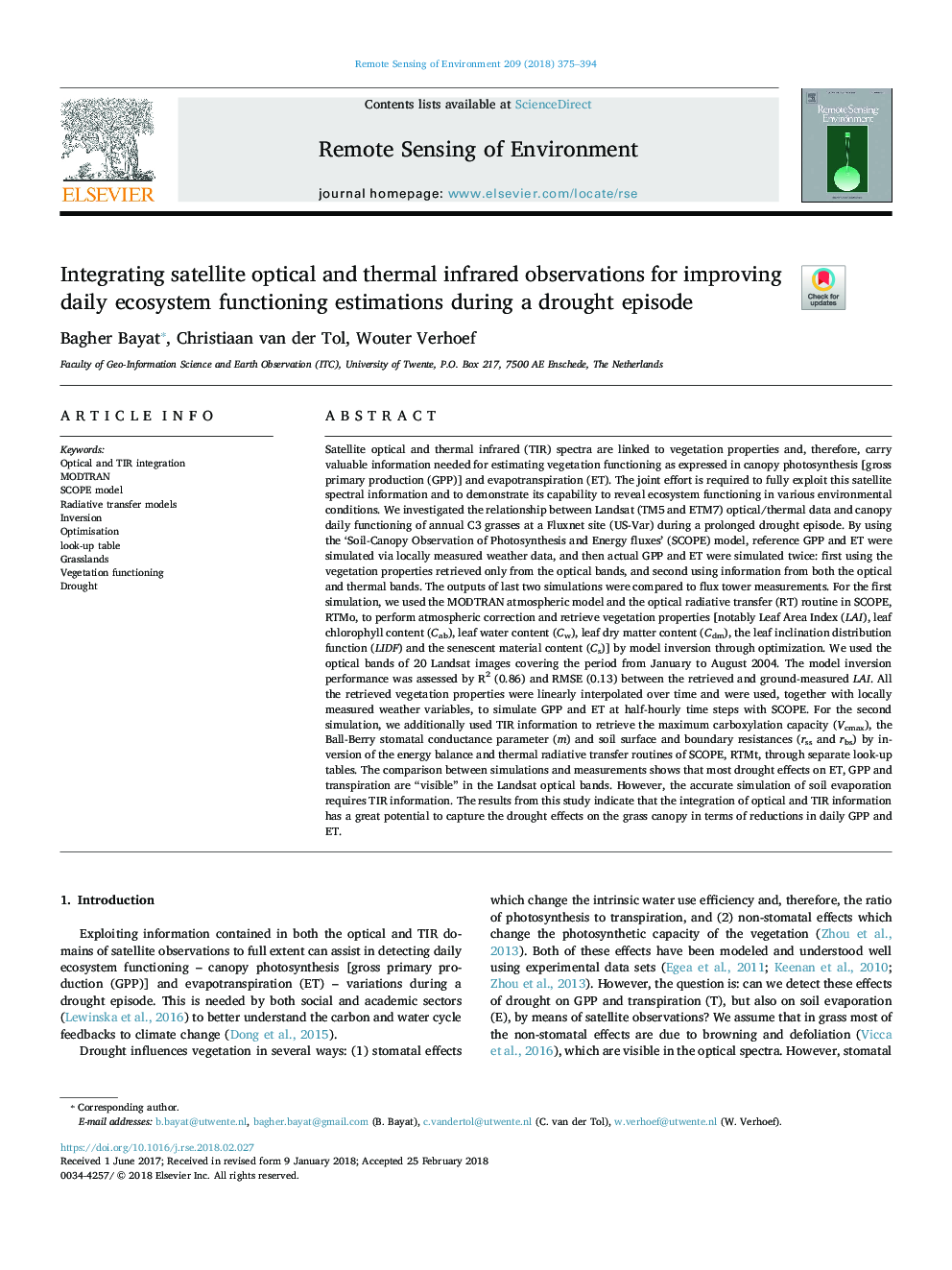| کد مقاله | کد نشریه | سال انتشار | مقاله انگلیسی | نسخه تمام متن |
|---|---|---|---|---|
| 8866646 | 1621191 | 2018 | 20 صفحه PDF | دانلود رایگان |
عنوان انگلیسی مقاله ISI
Integrating satellite optical and thermal infrared observations for improving daily ecosystem functioning estimations during a drought episode
ترجمه فارسی عنوان
یکپارچه سازی مشاهدات ماهواره ای نوری و حرارتی مادون قرمز برای بهبود تخمین عملکرد روزانه اکوسیستم در طول یک دوره خشکسالی
دانلود مقاله + سفارش ترجمه
دانلود مقاله ISI انگلیسی
رایگان برای ایرانیان
کلمات کلیدی
موضوعات مرتبط
مهندسی و علوم پایه
علوم زمین و سیارات
کامپیوتر در علوم زمین
چکیده انگلیسی
Satellite optical and thermal infrared (TIR) spectra are linked to vegetation properties and, therefore, carry valuable information needed for estimating vegetation functioning as expressed in canopy photosynthesis [gross primary production (GPP)] and evapotranspiration (ET). The joint effort is required to fully exploit this satellite spectral information and to demonstrate its capability to reveal ecosystem functioning in various environmental conditions. We investigated the relationship between Landsat (TM5 and ETM7) optical/thermal data and canopy daily functioning of annual C3 grasses at a Fluxnet site (US-Var) during a prolonged drought episode. By using the 'Soil-Canopy Observation of Photosynthesis and Energy fluxes' (SCOPE) model, reference GPP and ET were simulated via locally measured weather data, and then actual GPP and ET were simulated twice: first using the vegetation properties retrieved only from the optical bands, and second using information from both the optical and thermal bands. The outputs of last two simulations were compared to flux tower measurements. For the first simulation, we used the MODTRAN atmospheric model and the optical radiative transfer (RT) routine in SCOPE, RTMo, to perform atmospheric correction and retrieve vegetation properties [notably Leaf Area Index (LAI), leaf chlorophyll content (Cab), leaf water content (Cw), leaf dry matter content (Cdm), the leaf inclination distribution function (LIDF) and the senescent material content (Cs)] by model inversion through optimization. We used the optical bands of 20 Landsat images covering the period from January to August 2004. The model inversion performance was assessed by R2 (0.86) and RMSE (0.13) between the retrieved and ground-measured LAI. All the retrieved vegetation properties were linearly interpolated over time and were used, together with locally measured weather variables, to simulate GPP and ET at half-hourly time steps with SCOPE. For the second simulation, we additionally used TIR information to retrieve the maximum carboxylation capacity (Vcmax), the Ball-Berry stomatal conductance parameter (m) and soil surface and boundary resistances (rss and rbs) by inversion of the energy balance and thermal radiative transfer routines of SCOPE, RTMt, through separate look-up tables. The comparison between simulations and measurements shows that most drought effects on ET, GPP and transpiration are “visible” in the Landsat optical bands. However, the accurate simulation of soil evaporation requires TIR information. The results from this study indicate that the integration of optical and TIR information has a great potential to capture the drought effects on the grass canopy in terms of reductions in daily GPP and ET.
ناشر
Database: Elsevier - ScienceDirect (ساینس دایرکت)
Journal: Remote Sensing of Environment - Volume 209, May 2018, Pages 375-394
Journal: Remote Sensing of Environment - Volume 209, May 2018, Pages 375-394
نویسندگان
Bagher Bayat, Christiaan van der Tol, Wouter Verhoef,
